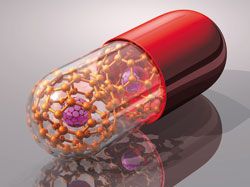Nanoparticles Demonstrate Potential for Small-Molecule Pharmaceuticals
PTSM: Pharmaceutical Technology Sourcing and Management
Nanoscale catalysts and engineered nanoparticles show promise for API synthesis and delivery.
LAGUNA DESIGN/GETTY IMAGES

Materials science, while often associated with industries other than bio/pharmaceuticals, also plays a significant role in the production of drug substances and formulated products, from reactor and purification equipment design to catalyst technology, the selection of polymorphs, the development of new drug-delivery technologies, and the choice of materials for medical devices. A selection of developments in nanocatalysis for API synthesis and nanoparticle technologies for more effective API delivery is discussed here.
The attraction of nanocatalysts
Many types of nanocatalysts have been developed and investigated as mediators of complex synthetic organic transformations. They are attractive because nanoparticles have different properties from their bulk counterparts, including high surface areas. Their electronic, optical, and magnetic properties are often vastly different from bulk materials, and consequently their reactivities are different on many levels. Synthetic chemists have sought to use these different behaviors to prepare highly stable nanocatalysts with high activities and selectivities. Magnetic nanocatalysts are of particular interest in organic synthesis because they can often be readily recovered and reused, while the separation of non-magnetic nanocatalysts that are also non-supported can be problematic.
Audrey H. Moores at McGill University in Canada focuses on the synthesis of novel magnetic, reusable metal nanocatalysts for coupling, hydrogenation, C-H activation, and oxidation. Robust, inexpensive, amphiphilic polymer-stabilized Fe(0) nanoparticle (Fe NP) catalysts developed by Moores are highly efficient for the hydrogenation of alkenes, alkynes, aromatic imines, and in ethanol or water in a flow reactor. Aliphatic amines and aldehydes, ketones, esters, arenes, and nitro and aryl halide groups are not affected (1). Nanocatalysts comprising Fe2O3 particles surrounded by nitrogen-doped graphene layers have also been shown by Matthias Beller of the Liebniz Institute for Catalysis and the University of Rostock in Germany to mediate the hydrogenation of structurally diverse and functionalized nitroarenes to anilines and the one-pot reductive amination of carbonyl compounds with nitroarenes (2). His group prepared more than 40 amines useful as building blocks for pharmaceuticals and other fine/specialty chemicals.
Moores has also shown that patches of palladium nanoparticles deposited on colloidal cellulose nanocrystallite (CNC) nanowhiskers catalyze the enantioselective hydrogenation of prochiral ketones in water at room temperature and 4 bar H2, achieving an enantiomeric excess of 65% with 100% conversion (3). Meanwhile, researchers at Birjand University and Payame Noor University in Iran deposited ionic liquids (ILs) on magnetic nanoparticles to overcome their limited recyclability (4). This approach led to increased activity of the ILs and their reduced consumption, and the heterogeneous nanoparticles were recoverable. The researchers suggest that the nanoparticle-stabilized ILs can be used as solvents, catalysts, or for the extraction of specific compounds that form bonds with the ILs.
Fighting poor solubility
A large number of small-molecule drug candidates under development today have poor solubility, and thus reduced bioavailability. In many cases, formulation strategies and drug delivery technologies can overcome this issue. Nanoparticles in particular can increase the stability of APIs, protect them against degradation, and enhance their bioavailability by increasing their solubilization, enhancing their permeability, reducing their rate of metabolism, and/or improving their transport.
While biodegradable polymers are often selected for the formation of nanoparticles, some researchers have focused on the use of lipids due to their greater physiologic similarity. Solid lipid nanoparticles (SLNs) also offer site-specific targeting, with high adhesion to the gut wall, which is an ideal location for the absorption of release APIs (5). In addition, both lipophilic and hydrophilic drugs can be incorporated into SLNs without the need to use organic solvents. It is important, however, to select an appropriate lipid for a given API to obtain crystalline SLNs with uniformly dispersed API and suitable lipophilicity for improved drug solubility. In some cases, biodegradable polymers may be used as surfactants to stabilize SLNs or as a surface coating to increase the biodistribution of APIs. Other excipients may also be used in SLN formulations, including non-polymeric nonioninc surfactants, cosolvents, and antioxidants.
Targeting delivery
As the potency of many drugs-particularly oncology APIs-increases, there is significant need for technologies that enable their targeted delivery to the site of action to minimize the unwanted side effects common with systemic delivery. Many researchers are turning to nanotechnology to achieve that goal. Careful design of nanoparticle properties, typically through modification of their surface properties, can enable their binding to specific components within the body and influence their API release behaviors.
Two examples of the use of nanotechnology for targeted drug delivery come from Southern California-based universities. In the first example, scientists from the California NanoSystems Institute at UCLA developed a nanoparticle delivery system for the antibiotic moxifloxacin that vastly improves the drug’s effectiveness against pneumonic tularemia, a type of pneumonia caused by inhalation of the bacterium Francisella tularensis. F. tularensis, which is highly infectious and designated as a top-tier bioterrorism agent (6), survives and multiplies within macrophages, particularly those in the liver, spleen, and lung. Jeffrey Zink and colleagues designed mesoporous silica nanoparticles that are readily taken up by macrophages. The nanoparticles are soaked overnight in a solution of the API, which is adsorbed in the pores. The pores are then blocked with nanovalves that are designed to degrade in the acidic environment of the macrophages. As a result, the drug is not distributed systemically, but only once it enters the macrophages. The approach allows for significantly more API to reach the site of infection without the side effects typically observed when moxifloxacin is administered freely into the blood stream (6). The researchers found that in mice given a lethal dose of F. tularensis, the nanoparticle-delivered moxifloxacin caused few side effects and was more effective at reducing the number of bacteria in the lungs than a dose of freely injected moxifloxacin two to four times greater.
Researchers at the University of California, San Diego Jacobs School of Engineering, led by Liangfang Zhang, have taken a different approach to targeted delivery using nanotechnology. In their case, nanoparticles formed of a biodegradable polymer were coated with fragments of human platelet membranes, which preferentially bind to damaged blood vessels and certain pathogens, such as Methicillin-resistant Staphylococcus aureus (MRSA) bacteria, and protect the nanoparticles from attack by the immune system (7). Unlike synthetic platelet mimics, the platelet membrane fragments possess the complete set of surface receptors, antigens, and proteins naturally present on platelet membranes. Once the platelet fragments bind to the desired site, the polymeric core degrades and is safely metabolized by the body, releasing the drug at the site of action. When nanoparticles loaded with docetaxel, a drug used to prevent scar tissue formation in the lining of damaged blood vessels, were administered to rats afflicted with injured arteries, the loaded nanoparticles were observed to selectively bind to the damaged sites of arteries and heal them (7).
Nanoparticles loaded with vancomycin at one-sixth the clinical dose and injected into mice systemically infected with MRSA bacteria resulted in up to a one-thousand-fold reduction of the bacterial counts than those in mice treated with the clinical dose of vancomycin alone (7).
A natural approach
A third approach to nanoparticle-based delivery of APIs relies on the use of nanoparticles formed from natural biomolecules. Silk fibroin (SF) has attracted particular attention due to its excellent biocompatibility, biodegradability, and low immunogenicity combined with a high binding capacity for many types of drugs, good controlled release properties, and ease of preparation (8). SF is an alternative to biodegradable polymers, such as poly (lactic acid) (PLA), poly (ε-caprolactone) (PCL), and poly (glycolic acid) (PGA) because protein-based nanoparticles bear functional groups that are naturally designed to interact with cells and cause biological responses. SF in particular is widely used as a biomaterial and is well characterized and understood. Studies of SF nanoparticle systems have shown that its biodegradation rate is influenced by its crystallinity, molecular weight, and degree of crosslinking. However, while numerous methods for the fabrication of nanoparticles have been developed, there is significant variation in the structure of SF obtained from different species and even individuals, and thus interest in genetically recombinant SF-based nanoparticles is increasing. Surface modifications are also required to improve the delivery specificity (8).
A nanoparticle-based formulation of the drug ormeloxifene (ORM) for the treatment of pancreatic cancer is under development by researchers at the Department of Pharmaceutical Sciences and the Center for Cancer Research at the University of Tennessee Health Science Center in order to enable tumor-specific targeted delivery (9). The ORM was readily encapsulated in poly(lactic-co-glycolic acid) nanoparticles that were then subjected to antibody/aptamer conjugation to achieve tumor-specific targeting. Cellular uptake and internalization studies with the 100-nm-diameter particles confirmed that they did not undergo lysosomal degradation and survived to allow efficient endosomal release. Treatment of a xenograft mice model resulted in increased animal survival and suppressed pancreatic tumor growth (9).
References
1. A. Moores et al., Green Chem.15 (8), 2141-2148 (2013).
2. M. Beller et al., Nature Protocols, 10, 548-557 (2015).
3. A. Moores et al., J. Am. Chem. Soc., 137 (19), 6124-6127 (2015).
4. S.M. Sadeghzadeh and M. Malekzadeh, J. Mol. Liq., 202 (1), 46-51 (2015).
5. A. Trevino and H. Chauhanm, Am. Pharm. Rev., April 2, 2015, Accessed Nov. 23, 2015.
6. J. Zink et al., ACS Nano, Article ASAP, Publication Date (Web): October 5, 2015.
7. L. Zhang et al., Nature, 526 (7571), 118-121, 2015.
8. Y. Li et al., Int. J. Mol. Sci. 16 (3), 4880-4903 (2015).
9. S.C. Chauhan et al., Biomaterials 53, 731-743 (2015).

Transformations in Drug Development for Cell and Gene Therapies
March 28th 2025As a recognized leader in immunophenotyping for clinical trials, Kevin Lang from PPD discusses how spectral flow cytometry is transforming drug development, particularly in cell and gene therapies like CAR-T. He also dives into his award-winning research, including his 2024 WRIB Poster Award-winning work, and his insights from presenting at AAPS PharmSci360.
Advancing Clinical Trials with Spectral Flow Cytometry: A Conversation with Kevin Lang
March 28th 2025As a recognized leader in immunophenotyping for clinical trials, Kevin Lang from PPD discusses how spectral flow cytometry is transforming drug development, particularly in cell and gene therapies like CAR-T. He also dives into his award-winning research, including his 2024 WRIB Poster Award-winning work, and his insights from presenting at AAPS PharmSci360.